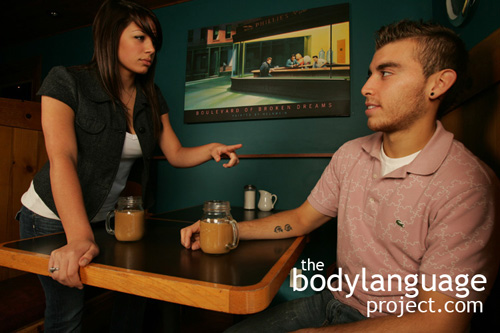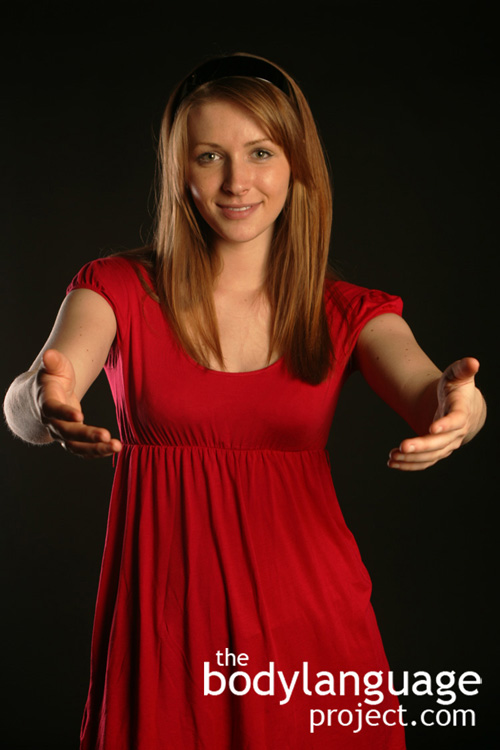Body Language of Cooperative Feet
Synonym(s): Feet Pointed Toward A Person.
Description: Cooperative feet are ones that are oriented toward a speaker rather than away. Their proximity is increased rather than decreased.
In One Sentence: When feet are pointed and are oriented toward a speaker, they indicate through direction and proximity, that a person is willing to cooperate.
How To Use it: Use feet to show the direction in which you are thinking and feeling. Feet can be pointed and extended toward the door if one wishes to leave. On the other hand, should a person or their ideas be of interest you should aim and extend your feet in their direction. While many people will only subconsciously be aware of your tactic, it will help reinforce your vocal words and help you maintain congruence. Matching your words with your body language will make you appear more honest and trustworthy.
When one wishes to show disinterest, simply turn the feet away. This can show others that you wish to leave or that you are not interested in what they are saying. This can serve you by increasing the chances they will make the conversation more interesting or if negotiation, advance a better offer.
Context: a) Dating b) Business
Verbal Translation: “I agree with you and my primitive mind is showing it by moving my feet toward you and pointing at you.”
Variant: See Toe Pointing or Pointed Toe, Buttress Stance or Foot Forward Leg Stance.
Cue In Action: a) Jill and Bill were really hitting it off, you could tell just by looking at their feet bellow the table. Both his and her feet were extended toward one another. b) At one point in the conversation the client was about to leave with his body aimed toward the door. Noticing his negative body language, the salesman quickly dropped his price 30%. The client pulled his feet back in and aimed them squarely at the salesman. The salesmen used his knowledge of body language to salvage the deal.
Meaning and/or Motivation: The direction that feet point coupled with their extension or withdrawal tells us much about how a person really feels about the situation. Feet move toward things they like and away from things they don’t like.
Feet are either cooperative or non-cooperative depending on how close they are to the stimulus and which way they point. In other words, as feet move closer, they are in agreement and when they are withdrawn, they are in disagreement. Also, feet usually point toward people and ideas they agree with and away from people and ideas they disagree with.
Millions of years ago, we gave up quadrupedalism to walk upright leaving our feet “to the dirt.” While our hands busied themselves with other complex tasks like building fires, making clothing and shelters and throwing spears our legs were relegated to more primitive activities like locomotion. The feet on the other hand, carried out more traditional tasks like escaping predators, avoiding hot sand or coals from the fire, leaping from slithering snakes or poisonous spiders, or navigating rough rocking river bottoms. The feet were therefore connected more to the reptilian brain that reacts to stimuli directly instead of contemplating higher order tasks that require planning.
When we’re frightened it doesn’t take much to put our feet in gear. For example, feet are quickly tucked under our legs and coiled up ready to flee with any indication of danger. For example, the shadow of a mouse scampering across the room forces our feet to instantly freeze, or be pulled onto a chair.
Our feet carry the flight or fight reaction to the letter making them honest.
Our feet and legs can display boredom through repetitive motions, joy by lifting the body up and down, fear by being tucked under a chair, depression by laying lazily or motionless and sensuality by being uncovered and flaunted.
Cue Cluster: Cooperative feet are accompanied by other agreement indicators such as palms up rather than down, arms uncrossed, head tilted at forty five degrees, eye contact, ventral fronting and head nods.
Body Language Category: Attentive, Body pointing, Courtship display, Honest body language or honesty, Indicator of interest (IoI), Indicators of sexual interest (IOsI), Intention movements, Liking, Open body language, Orienting reflex or orienting response, Undivided attention (nonverbal).
Resources:
Astrom, Jan. Introductory greeting behavior: a laboratory investigation of approaching and closing salutation phases. Perceptual and Motor Skills. 1994. 79(2): 863(35).
Aiello, J. 1977. A further look at equilibrium theory. Visual interaction as a function of
interpersonal distance. Environmental Psychology & Nonverbal Behavior, 1: 122-140.
Argyle, M., & Dean, I. Eye contact, distance and affiliation. Sociometry, 1965, 28, 289-304.
Brault, Sébastien ; Bideau, Benoit ; Kulpa, Richard ; Craig, Cathy M ; Gribble, Paul L. Detecting Deception in Movement: The Case of the Side-Step in Rugby. PLoS ONE. 2012. 7(6).
Boucher, Michael L. Holzberg, Jules D. (editor). Effect of seating distance on interpersonal attraction in an interview situation. Journal of Consulting and Clinical Psychology. 1972 38(1): 15-19.
Broth, Mathias and Lorenza Mondada. Walking Away: The Embodied Achievement of Activity Closings in Mobile Interaction. Journal of Pragmatics. 2013. 47: 41-58.
http://bodylanguageproject.com/articles/nonverbally-negotiate-conversation-walking-away/
Baxter, James C. ; Rozelle, Richard M. Lanzetta, John T. (editor). Nonverbal expression as a function of crowding during a simulated police-citizen encounter. Journal of Personality and Social Psychology. 1975. 32(1): 40-54.
Cacioppo, J. T., Hawkley, L. C., Crawford, L. E., Ernst, J. M., Burleson, M. H., Kowalewski, R. B., et al. (2002). Loneliness and health: Potential mechanisms. Psychosomatic Medicine. 2002; 64: 407-417.
Cook, Mark. 1970. Experiments on orientation and proxemics. Human Relations 23 (1): 61-76.
Cook, M. Experiments on orientation and proxemics. Human Relations, 1970, 23, 61-67.
Clack, B., Dixon, J., & Tredoux, C. (2005). Eating together apart: Patterns of segregation in a multi-ethnic cafeteria. Journal of Community & Applied Social Psychology, 15, 1-16. doi:10.1002/casp.787
Castelli, Luigi ; Carraro, Luciana ; Pavan, Giulia ; Murelli, Elisa ; Carraro, Alessia. The Power of the Unsaid: The Influence of Nonverbal Cues on Implicit Attitudes. Journal of Applied Social Psychology. 2012 42(6): 1376-1393.
Coutts, Larrym. ; Ledden, Maribeth. Nonverbal Compensatory Reactions to Changes in Interpersonal Proximity. The Journal of Social Psychology. 1977 102(2): 283-290.
Dolphin, Carol Zinner. Beyond hall: Variables in the use of personal space in intercultural transactions. Howard Journal of Communications. 1988. 1(1): 23-38.
Eerland, Anita; Tulio M. Guadalupe; Ingmar H. A. Franken and Rolf A. Zwaan. Posture as Index for Approach-Avoidance Behavior. PLOS one. February 2012. 7(2): e31291.
http://bodylanguageproject.com/articles/approach-versus-avoidance-posture-in-nonverbal-body-language/
Fisch, Hans-ulrich ; Frey, Siegfried ; Hirsbrunner, Hans-peter Buchwald, Alexander M. (editor). Analyzing nonverbal behavior in depression. Journal of Abnormal Psychology. 1983. 92(3): 307-318.
Felipe, N. Interpersonal distance and small group interaction. Cornell Journal of Social Relations, 1966, 1, 59-64.
Felipe, N. Connotations of seating arrangements. Cornell Journal of Social Relations, 1967, 2, 37-44.
Goodboy, Alan, K. and Maria Brann. Flirtation Rejection Strategies: Towards an Understanding of Communicative Disinterest in Flirting. The Quantitative Report. 2010. 15(2): 268-278.
http://bodylanguageproject.com/articles/how-to-reject-flirting-using-nonverbal-and-verbal-tactics/
Gifford, Robert ; O’Connor, Brian. Nonverbal intimacy: Clarifying the role of seating distance and orientation. Journal of Nonverbal Behavior. 1986 10(4): 207-214.
Gardin, Hershel ; Kaplan, Kalman J. ; Firestone, Ira J. ; Cowan, Gloria A. Lanzetta, John T. (editor). Proxemic effects on cooperation, attitude, and approach-avoidance in a Prisoner’s Dilemma game. Journal of Personality and Social Psychology. 1973. 27(1): 13-18.
Greenberg, Carl I. ; Firestone, Ira J. Greenwald, Anthony G. (editor). Compensatory responses to crowding: Effects of personal space intrusion and privacy reduction. Journal of Personality and Social Psychology. 1977. 35(9): 637-644.
Graziano, Michael S.A. and Cooke, Dylan F. Parieto-frontal interactions, personal space, and defensive behavior. Neuropsychologia. 2006. 44(6): 845-859.
Holt, Daphne J ; Cassidy, Brittany S ; Yue, Xiaomin ; Rauch, Scott L ; Boeke, Emily A ; Nasr, Shahin ; Tootell, Roger B H ; Coombs, Garth. Neural correlates of personal space intrusion. The Journal of neuroscience : the official journal of the Society for Neuroscience. 2014. 34(12): 4123-34.
Harrison, Cathie. Watching the children watching Play School: indicators of engagement, play and learning. Australasian Journal of Early Childhood. 2012. 37(4): 44(7).
Harrigan, Jinni ; Oxman, Thomas ; Rosenthal, Robert. Rapport expressed through nonverbal behavior. Journal of Nonverbal Behavior. 1985. 9(2): 95-110.
Hall, Jeffrey A. and Chong Xing. The Verbal and Nonverbal Correlates of the Five Flirting Styles. Journal of Nonverbal Behavior. 2015. 39:41–68. DOI 10.1007/s10919-014-0199-8
http://bodylanguageproject.com/articles/first-12-minutes-flirting-using-nonverbal-communication-study-reveals-26-body-language-cues-attraction/
Haase, Richard F. ; Dimattia, Dominic J. Berdie, Ralph F. (editor). Proxemic behavior: Counselor, administrator, and client preference for seating arrangement in dyadic interaction. Journal of Counseling Psychology. 1970 17(4): 319-325.
IJzerman, Hans; Marcello Gallucci; Wim T.J.L. Pouw; Sophia C. Weigerber; Niels J. Van Doesum and Kipling D. Williams. Cold-Blooded Loneliness: Social Exclusion Leads To Lower Skin Temperatures. Acta Psychologica. 2012. 140:283-288. http://bodylanguageproject.com/articles/body-temperature-actually-drops-during-social-exclusion/
Katza, Carmit; Irit Hershkowitz; Lindsay C. Malloya; Michael E. Lamba; Armita Atabakia and Sabine Spindlera. Non-Verbal Behavior of Children Who Disclose or do not Disclose Child Abuse in Investigative Interviews. Child Abuse & Neglect. 2012. 36: 12-20.
http://bodylanguageproject.com/articles/reading-nonverbal-behaviour-child-abuse-cases-encourage-children-divulge-information-truth-telling/
Kenner, Andrew N. ; Katsimaglis, George. Gender differences in proxemics: taxi-seat choice. Psychological Reports. 1993 72(2): 625(2).
Moore, Monica. Courtship Signaling and Adolescents: Girls Just Wanna Have Fun. Journal of Sex Research. 1995. 32(4): 319-328.
http://bodylanguageproject.com/articles/girls-just-want-to-have-fun-the-origins-of-courtship-cues-in-girls-and-women/
Mehrabian, Albert Holzberg, Jules D. (editor). Inference of Attitudes From the Posture, Orientation and Distance of a Communicator. Journal of Consulting and Clinical Psychology. 1968. 32(3): 296-308.
Mehrabian, Albert Deese, James (editor). Significance of posture and position in the communication of attitude and status relationships. Psychological Bulletin. 1969. 71(5): 359-372
Mackinnon, Sean P. ; Jordan, Christian H. ; Wilson, Anne E. Birds of a feather sit together: Physical similarity predicts seating choice. Personality & Social Psychology Bulletin. 2011 37(7): 879(14).
Mcelroy, James C. ; Morrow, Paula C. Personal space, personal appearance, and personal selling. Psychological Reports. 1994 74(2): 425(2).
Mcgurk, Barry J. ; Davis, John D. ; Grehan, John. Assaultive behavior personality and personal space. Aggressive Behavior. 1981. 7(4): 317-324.
Navarro, Joe. 2008. What Every BODY is Saying: An Ex-FBI Agent’s Guide to Speed-Reading People. William Morrow Paperbacks.
Newman, Robert C. ; Pollack, Donald Holzberg, Jules D. (editor). Proxemics in deviant adolescents. Journal of Consulting and Clinical Psychology. 1973 40(1): 6-8.
Pitterman, Hallee ; Nowicki Jr, Stephen. A Test of the Ability to Identify Emotion in Human Standing and Sitting Postures: The Diagnostic Analysis of Nonverbal Accuracy-2 Posture Test (DANVA2-POS). Genetic, Social, and General Psychology Monographs. 2004. 130(2): 146-162.
Remland, M. S. and T. S. Jones 1995. Interpersonal Distance, Body Orientation, and Touch: Effects of Culture, Gender, and Age. Journal of Social Psychology 135(3): 281-297.
Remland, M. S. and T. S. Jones 1995. Interpersonal Distance, Body Orientation, and Touch: Effects of Culture, Gender, and Age. Journal of Social Psychology 135(3): 281-297.
Rovers, A.F. ; Essen, H.A. Guidelines for haptic interpersonal communication applications: an exploration of foot interaction styles. Virtual Reality. 2006. 9(2): 177-191.
Ricard, Nathalie C. ; Beaudry, Simon G. ; Pelletier, Luc G. Lovers With Happy Feet: The Interdependence of Relationship and Activity Factors for Individuals Dancing With a Romantic Partner.(Report). Journal of Applied Social Psychology. 2012. 42(4): 939(25).
Sartori, Luisa ; Becchio, Cristina ; Castiello, Umberto. Cues to Intention: The Role of Movement Information. Cognition. 2011. 119(2): 242-252.
Sporer, Siegfried L. ; Schwandt, Barbara Penrod, Steven D. (editor). Moderators of Nonverbal Indicators of Deception: A Meta-Analytic Synthesis. Psychology, Public Policy, and Law. 2007. 13(1): 1-34.
Scherer, S. E., & Schiff, M. R. Perceived intimacy, physical distance, and eye contact. Perceptual and Motor Skills, 1973, 36, 835-841.
Scott, J. A. Comfort and seating distance in living rooms: The relationship of interactants and topic of conversation. Environment and Behavior, 1984, 16, 35-54.
Sommer, R. Studies in personal space. Sociometry, 1959, 22,247-260.
Sommer, R. The distance for comfortable conversation: A further study. Sociometry, 1962, 25, 111-116.
Sommer, R. Personal space: The behavioral basis of design. Englewood Cliffs, New Jersey: Prentice Hall. 1969.
Uchino, B. N., Cacioppo, J. T., & Kiecolt-Glaser, J. K. (1996). The Relationship Between Social Support And Psychological Processes: A Review With Emphasis On Underlying Mechanisms And Implications For Health. Psychological Bulletin. 1996; 119: 488-531.
Underwood, M. K.. Glares of Contempt, Eye Rolls of Disgust and Turning Away to Exclude: Non-Verbal Forms of Social Aggression among Girls. Feminism & Psychology. 2004 14(3): 371-375
Werner, Carol ; Brown, Barbara ; Damron, Gary Steiner, Ivan D. (editor). Territorial marking in a game arcade. Journal of Personality and Social Psychology. 1981. 41(6): 1094-1104.
Whittock, Trevor. The role of metaphor in dance. The British Journal of Aesthetics. 1992. 32(3): 242(8).
Weiss, M., & Keys, C. The influence of proxemic variables on dyadic interaction between peers. Paper presented at the meeting of the American Psychological Association; Chicago, 1975, August.
Willis, F. 1966. Initial speaking distance as a function of the speaker’s relationship.
Psychonomic Science. 5: 221-222.
Zeinstra, Gertrude G.; M.A. Koelen; D. Colindres ; F.J. Kok; C de Graaf. Facial Expressions in School-Aged Children are a Good Indicator of ‘Dislikes’, but not of ‘Likes.’ Food Quality and Preference. 2009. 20: 620-624.
http://bodylanguageproject.com/articles/read-kids-dislike-food-facial-expressions-accurate-detecting-dislike-not-like-children/




